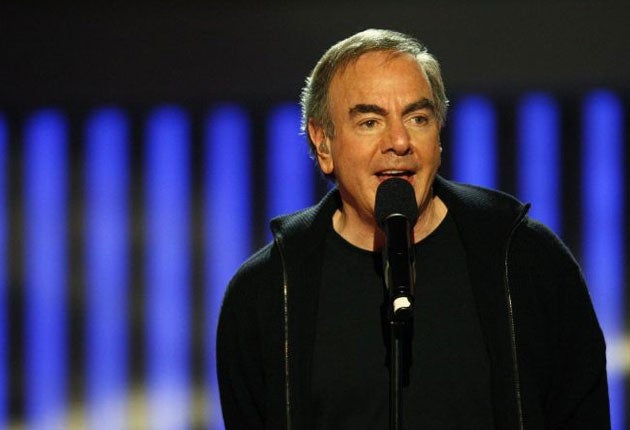Duck for cover from these vapid veterans
New versions of old classics can be revelatory, says Elisa Bray – but more often than not, they're uninspiring chart fodder

Your support helps us to tell the story
From reproductive rights to climate change to Big Tech, The Independent is on the ground when the story is developing. Whether it's investigating the financials of Elon Musk's pro-Trump PAC or producing our latest documentary, 'The A Word', which shines a light on the American women fighting for reproductive rights, we know how important it is to parse out the facts from the messaging.
At such a critical moment in US history, we need reporters on the ground. Your donation allows us to keep sending journalists to speak to both sides of the story.
The Independent is trusted by Americans across the entire political spectrum. And unlike many other quality news outlets, we choose not to lock Americans out of our reporting and analysis with paywalls. We believe quality journalism should be available to everyone, paid for by those who can afford it.
Your support makes all the difference.It's that time of year when pop artists dig out old hits, dust them off and give them a sheen of their own. The cover song is back, and could even be this year's Christmas No 1, if Ellie Goulding's version of Elton John's "Your Song" keeps up its sales.
It's in her cover songs that Goulding's vocals offer the most emotion. When she covered Bon Iver's "The Wolves", even some of the latter's most reverent fans voiced their approval. One of its draws was the unexpected – here was an electropop, chart-topping singer performing a revered indie song. In the best cases, a cover reveals another layer to an artist we feel we already know.
The cover single seems to be enjoying a renaissance. And it's not just the X Factor winner or those musicians "recording" John Cage's silent work "4'33''" as an anti-X Factor campaign. Rather than belonging exclusively to acts of a certain status, rising bands of all genres are doing covers, as a public way of acknowledging their influences. The BBC Sound of 2011-tipped James Blake has a compelling cover of Feist's "Limit to Your Love", D M Stith's cover of Randy Newman's "Suzanne" is excellent, as is Canadian Basia Bulat's take on Sam Cooke's "Touch the Hem of His Garment".
The odd cover song can be a treat, but a whole album of covers is only a good thing when the act sets out to do something entirely new. Among all of the repackaged, deluxe versions of albums in the lead up to Christmas, there have been several devoted to covers, including new releases from Neil Diamond and Jason Donovan. The latter explained in a recent interview that he'd reached the "covers stage" of his career. It sounds cynical, but Donovan has a point with his Soundtrack of the 80s, a collection of covers of 80s songs. Have a great name, but lacking in artistic inspiration? Why not release a covers album?
Yet sales figures aside, an entire album of covers, especially when the material is so obvious, adds little of artistic worth. Neil Diamond's new album, Dreams, is another case in point. An excellent example of the "covers stage", in Dreams he offers up an amalgam of well-known, predictable hits. Paul Anka has also milked the commercial opportunities with his album of rock covers, including a cover of Spandau Ballet's "True". George Michael released a covers album back in 1999, while Lulu made an album of cover duets featuring such commercial and non-forward-thinking pop acts as Ronan Keating and Westlife, and veteran stars Cliff Richard and Paul McCartney. In all cases, the material chosen is predictable, mainstream – and lacking in imagination.
A good cover offers something entirely unexpected from the artist, delivered in a unique way that surprises the listener. It can be difficult to achieve right across an entire album – and not just for solo artists. Compilations face the same hurdle. The charity album Dark Was the Night, produced by The National's Aaron and Bryce Dessner, with such beloved indie heroes as Bon Iver, Grizzly Bear, Cat Power, Sufjan Stevens, Stuart Murdoch and Blonde Redhead contributing, was a promising prospect. And though it offered some gems (songs from Stevens and Dirty Projectors/ David Byrne included), there were a couple too many throwaway songs (including Dave Sitek's cover of "With a girl like you").
Covers-only projects Headless Heroes and Nouvelle Vague could hardly be accused of lacking in imagination, though. And Joan as Policewoman, who used to play in Antony Hegarty's backing band and is now an indie star in her own right, also did an album of pleasingly wide-ranging covers in 2009 called Cover.
Some genres have a tradition of covers. In country music, the heritage is arguably the glue, and the same could be said of folk, reggae, and jazz, although all styles have their progressive strands, too. In pop, however, it's all about forward-thinking. Musicians can keep doing inventive covers, but should avoid falling prey to the commercial bait of a covers album. Submitting to the "covers stage" of one's career can be most undignified.
Join our commenting forum
Join thought-provoking conversations, follow other Independent readers and see their replies
Comments